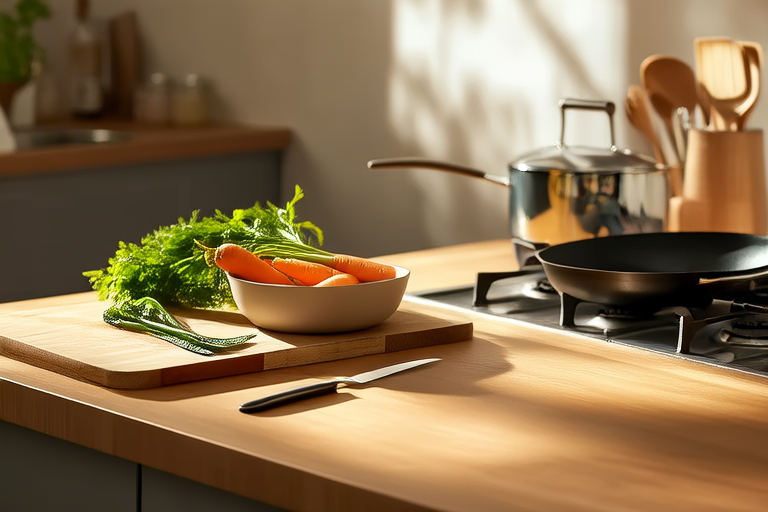Discover How Simple Cooking Hacks Can Make You a Better Cook
Introduction: Why Cooking Hacks Matter
Cooking is an art that combines creativity, patience, and technique. Whether you’re a seasoned chef or a beginner in the kitchen, there are always ways to improve your cooking skills. One of the best ways to do this is by incorporating simple yet effective cooking hacks into your routine. These hacks can save time, enhance flavor, and ensure that your dishes turn out perfectly every time. In this article, we’ll explore some of the most useful cooking hacks that can elevate your culinary game.
Hack 1: Mastering Knife Skills
The Importance of Proper Knife Handling
One of the most fundamental aspects of cooking is mastering your knife skills. A sharp and well-maintained knife can make all the difference in the kitchen. Not only does it speed up your prep time, but it also ensures that your ingredients are evenly cut, which is crucial for even cooking and presentation.
Tips for Sharpening and Maintaining Your Knives
- Use a sharpening stone: Regularly sharpen your knives with a sharpening stone to keep them in top condition.
- Avoid dulling on cutting boards: Always use a cutting board made from wood or plastic, as metal surfaces can dull your knives quickly.
- Store knives properly: Invest in a magnetic strip or a knife block to prevent damage when not in use.
Techniques for Efficient Cutting
- Chiffonade: This technique is perfect for leafy greens like basil or spinach. Stack the leaves, roll them tightly, and slice thinly across the roll.
- Julienne: Slice vegetables into thin strips for a uniform texture, ideal for stir-fries and salads.
- Mirepoix: Learn to chop onions, carrots, and celery in precise proportions (2:1:1) to form the base of many soups and stews.
Hack 2: Enhancing Flavor with Seasoning
Understanding the Role of Salt
Salt is often overlooked, but it plays a crucial role in enhancing flavors. It brings out the natural sweetness in foods and balances acidity. However, using too much salt can overpower other flavors. Learning how to season correctly is key to achieving balanced and delicious meals.
Experimenting with Herbs and Spices
- Herb pairings: Combine fresh herbs like thyme, rosemary, and parsley to add depth to meats and vegetables.
- Spice blends: Create your own spice blends for different cuisines, such as Italian seasoning (oregano, basil, garlic powder) or garam masala (cumin, coriander, cardamom).
Cooking with Acid
Adding a splash of vinegar, lemon juice, or lime can brighten up any dish. Acid helps cut through richness and adds complexity to sauces and marinades.
Hack 3: Perfecting Timing and Temperature
The Science Behind Cooking Temperatures
Understanding the optimal cooking temperatures for various foods is essential. For example, steaks should be cooked at high heat for a sear and then lowered to medium heat for even cooking. Knowing these temperature ranges can help you achieve the desired doneness without overcooking.
Using Thermometers for Precision
Investing in a reliable food thermometer can take the guesswork out of cooking. Use it to check the internal temperature of meats, poultry, and fish to ensure they are cooked safely and evenly.
Timing Techniques for Multistep Recipes
When preparing complex dishes, timing is everything. Create a timeline for each step and set timers to avoid rushing or forgetting a component. For instance, start rice or pasta early so it’s ready when you need it.
Hack 4: Creative Food Presentation
The Impact of Presentation on Taste Perception
How your food looks can significantly influence how it tastes. A beautifully presented dish can elevate the dining experience and impress guests. Pay attention to color, texture, and arrangement to create visually appealing plates.
Simple Tricks for Better Plating
- Balance: Ensure there is a balance between solid and liquid elements on the plate.
- Contrast: Use contrasting colors and textures to make the dish more engaging.
- Symmetry: Arrange components symmetrically for a polished look.
Hack 5: Efficient Kitchen Organization
Keeping Your Workspace Clean and Organized
A cluttered kitchen can lead to mistakes and wasted time. Keep your workspace clean and organized by storing ingredients and tools in designated areas. Label containers for easy identification and use drawer dividers to keep utensils neatly arranged.
Utilizing Kitchen Tools Wisely
- Reusable silicone baking mats: These can replace parchment paper and reduce waste.
- Mandoline slicers: Perfect for quick and precise slicing of vegetables.
- Silicone spatulas: Ideal for scraping bowls and mixing batter efficiently.
Practical Case Study: Roasted Chicken with Herb-Crusted Potatoes
Step-by-Step Guide
- Prepare the potatoes: Preheat your oven to 400°F (200°C). Peel and dice potatoes, toss with olive oil, salt, pepper, and chopped herbs (thyme, rosemary).
- Season the chicken: Rub the chicken inside and out with olive oil, salt, and pepper. Stuff the cavity with lemon slices and fresh herbs.
- Roast together: Place the potatoes around the chicken in a roasting pan. Roast for 1 hour or until the chicken reaches an internal temperature of 165°F (74°C).
- Rest and serve: Let the chicken rest for 10 minutes before carving. Serve with the herb-crusted potatoes for a flavorful and visually appealing meal.
Conclusion: Putting It All Together
By integrating these simple cooking hacks into your routine, you can become a better cook. From mastering knife skills to perfecting seasoning and timing, each tip contributes to improving both the quality and efficiency of your cooking. Remember, practice makes perfect, so keep experimenting and refining your techniques. With consistent effort, you’ll soon find yourself creating delicious, restaurant-quality meals at home. Happy cooking!
